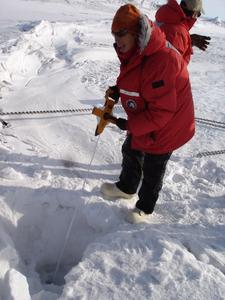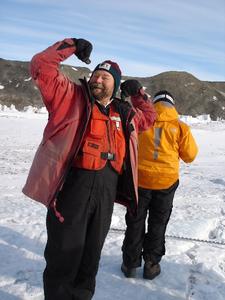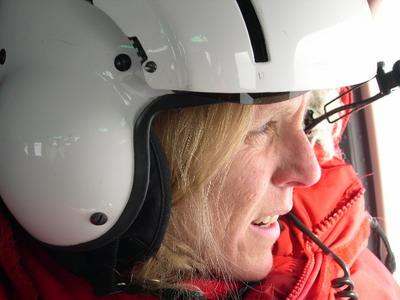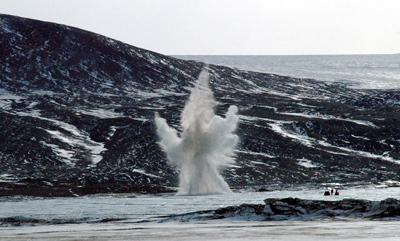25 October, 2004
Cape Chocolate and Skidoo!
This morning I was lucky enough to get to go with Stacy, Mike and Rob Robbins, the diver coordinator, over to Cape Chocolate to try to find a crack where a hole can be blasted for diving. It's much easier to start with an existing break in the ice, such as a crack, than to try to make a hole through the full thickness of the ice.
Before flying in the helicopter, we have to be weighed, and our bags have to be weighed, as well as all cargo we're taking with us. Not exceeding cargo weight is critical for any aircraft, especially a helicopter. We also eacg had to select a helmet. The helmet provides protection like any other helmet, but it also helps block out the noise of the helicopter rotors, and it has a microphone on the front, as well as speakers inside so we can communicate. We also received a briefing from Andree, our "helo tech." She reinforced what we had seen in the helo training video: Don't approach the helicopter until the pilot has told you to do so; stay low; don't go near the tail rotors if you like having having your head attached to your body; don't carry long objects vertically. Getting something caught in the tail rotors can cause injury and easily damage the helicopter so badly it can't fly.
The equipment we needed for the day, as well as some things we were going to leave there - a generator and four scuba tanks - were loaded onto the helicopter and we were ready to go. We could see steam rising from Erebus as we took off from McMurdo. It didn't seem very long before we were approaching Cape Chocolate, on the other side of McMurdo Sound. There is a small, dark island off the coast of Cape Chocolate, and it was there that Rob saw a crack that he thought might a good place for the dive hole. Barry, our pilot, landed near the crack and we all got out to look. Between the crack and shore were some big pressure ridge cracks. They are very impressive to see up close.
Rob drilled at the site and found that the ice was 10 feet thick - good news. It should be thick enough to support everyone's weight, but not so thick that it would be difficult to blast or dive through, Then Stacy measured the depth through the drilled hole and found that the water was about 70 feet deep. Perfect! They had found a good crack on the first try. Before diving, blasters need to make a hole in the ice using explosives. See the picture below of a hole being blasted at New Harbor, where another team is diving now and this team will dive in November.
We enjoyed walking around and checking out the site where we will be living and working for the next few days. Beyond the island, there is the mainland, with Hobbs Glacier coming down into Salmon Bay. The soil here is dark down near the water, but paler and almost yellowish in the small overlooking mountains and hills. I wonder why?
Finally, we moved the generator and four scuba tanks that were to be left until our arrival. Stacy recorded the position of the tanks and generator in a handheld GPS (Global Positioning System) unit so that there will be no question where these items are located. A GPS uses satellites to determine the location of a place on the earth and stores the latitude and longitude of that place. The position can also be placed on a map in the unit.
The flight back from Cape Chocolate was even better because our view was improved with the generator no longer in there with us. We flew over dark, volcanic islands, and snow and ice in all kinds of textures. Some people think of Antarctica as just plain and white, but there are so many details in just one small place on the sea ice that you could spend a long time looking at it. In some places we could see blue ice where there was no snow. The ice is really clear, but looks blue because of the way the light is refracted (bent) through it. Erebus was awesome as usual, with a long plume of vapor streaming off it, and a shadow of the vapor on the slope of the mountain.
I'm really excited that we will be going out in the field. We'll sleep in tents and cook over camp stoves. It seems to me that it's going to be very cold for the divers, since they won't have a warm hut to emerge into; they'll just be diving from the edge of the ice. But they are tough! And we will ply them with hot chocolate!
After lunch I was interviewed by Brien Barnett for the McMurdo newspaper, the Antarctic Sun. There will be an arcticle about what I'm doing in the next issue.
After that, I had another treat - I'm really getting spoiled here, getting to go to Cape Chocolate this morning and then this afternoon going to Cinder Cones by ski-doo (snowmobile). I'd never been on a snowmobile before, and the ones we're using are pretty old (Andrew figures they're older than he is), so starting it was a challenge. Then I pulled the starting cord too far and it wouldn't wind back in, so Jennifer was really nice and offered to let me ride hers instead while she stayed behind to get the ski-doo repaired.
I had heard a lot about how cold it is to ride the ski-doos, so I was dressed as though I were going to be camping out at the South Pole! In no time, I was boiling after trying to start the ski-doo. But at least I was nice and toasty as we went out the ice road to the dive hut. It's a lot faster trip on the ski-doo than in the Pisten Bully and Mattrack, and a lot of fun. I tried watching the scenery, but since it was my first time, I thought I'd better pay more attention to my driving. It was a beautiful ride, though.
Once at Cinder Cones, it didn't take Andrew, Mike, and me too long to chip out the cookie holding open the dive hole and break the ice off the top of the hole. We left the cookie off because by the time they come back to this site to dive, the hole will be frozen over enough to require a chainsaw to open it up again anyway.
The ride back was even more exciting, with Mike in the lead - at least I think it was MIke. Mostly I just saw a cloud of snow with a dot of red in the middle.
Tomorrow we will go to Cape Chocolate in two separate helicopter flights. Mine is at 9:00, so I need to check in at 8:15 to be weighed and briefed before the flight.

1. Mike weighs in for the helo flight.


3. Rob Robbins drills to find water, 10 feet below the surface of the ice.

4. Stacy measrues the depth of the water under the ice - about 70 feet to the bottom.

5. Barry, our fearless pilot. He's thinking about becoming a teacher! I said "Why would anyone ever want to do that?" JUST KIDDING!

6. Stacy checks out the site where we will live and work for the next few days.

7. Stacy enters the position of the generator and scuba tanks into the GPS.

8. Checking out the amazing view out the window of the helo.

9. Stacy received this picture from Henry Kaiser, a diver on another project. A hole is being blasted in the ice for a dive site at New Harbor, where Stacy's team will dive in November.

10. Andrew parks the skidoo after a fun ride out to Cinder Cones.
Contact the TEA in the field at
.
If you cannot connect through your browser, copy the
TEA's e-mail address in the "To:" line of
your favorite e-mail package.
|
